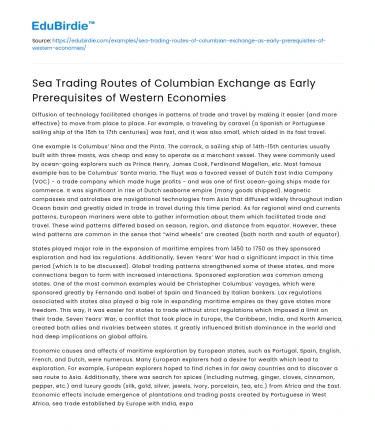Diffusion of technology facilitated changes in patterns of trade and travel by making it easier (and more effective) to move from place to place. For example, a traveling by caravel (a Spanish or Portuguese sailing ship of the 15th to 17th centuries) was fast, and it was also small, which aided in its fast travel.
One example is Columbus’ Nina and the Pinta. The carrack, a sailing ship of 14th-15th centuries usually built with three masts, was cheap and easy to operate as a merchant vessel. They were commonly used by ocean-going explorers such as Prince Henry, James Cook, Ferdinand Magellan, etc. Most famous example has to be Columbus’ Santa maria. The fluyt was a favored vessel of Dutch East India Company (VOC) - a trade company which made huge profits - and was one of first ocean-going ships made for commerce. It was significant in rise of Dutch seaborne empire (many goods shipped). Magnetic compasses and astrolabes are navigational technologies from Asia that diffused widely throughout Indian Ocean basin and greatly aided in trade in travel during this time period. As for regional wind and currents patterns, European mariners were able to gather information about them which facilitated trade and travel. These wind patterns differed based on season, region, and distance from equator. However, these wind patterns are common in the sense that “wind wheels” are created (both north and south of equator).
Save your time!
We can take care of your essay
- Proper editing and formatting
- Free revision, title page, and bibliography
- Flexible prices and money-back guarantee
States played major role in the expansion of maritime empires from 1450 to 1750 as they sponsored exploration and had lax regulations. Additionally, Seven Years’ War had a significant impact in this time period (which is to be discussed). Global trading patterns strengthened some of these states, and more connections began to form with increased interactions. Sponsored exploration was common among states. One of the most common examples would be Christopher Columbus’ voyages, which were sponsored greatly by Fernando and Isabel of Spain and financed by Italian bankers. Lax regulations associated with states also played a big role in expanding maritime empires as they gave states more freedom. This way, it was easier for states to trade without strict regulations which imposed a limit on their trade. Seven Years’ War, a conflict that took place in Europe, the Caribbean, India, and North America, created both allies and rivalries between states. It greatly influenced British dominance in the world and had deep implications on global affairs.
Economic causes and affects of maritime exploration by European states, such as Portugal, Spain, English, French, and Dutch, were numerous. Many European explorers had a desire for wealth which lead to exploration. For example, European explorers hoped to find riches in far away countries and to discover a sea route to Asia. Additionally, there was search for spices (including nutmeg, ginger, cloves, cinnamon, pepper, etc.) and luxury goods (silk, gold, silver, jewels, ivory, porcelain, tea, etc.) from Africa and the East. Economic effects include emergence of plantations and trading posts created by Portuguese in West Africa, sea trade established by Europe with India, expansion of slave trade, triangular trade route and Columbian exchange, and rise of capitalism and mercantilism. Christopher Columbus played a major role in discovery of western lands with intentions of sailing to Asian markets (tried to find route to Asia). As for trading-post empires, first built by Portuguese mariners in 16th to 17th century, they control trade routes by forcing merchant vessels to pay duties at fortified trading sites. Their goal was not an attempt to create empires or conquer territories, but rather to control trade and wealth.
Causes of Columbian exchange included European exploration of world, empire building, discovery of Americas (and colonization of lands by Spain and Portugal), introduction of European culture, goods (and crops), people (which lead to increase in population of some areas), diseases, and ideas to the Americas, and the quest for God, Gold, and Glory. The exchange had major effects on both western and eastern hemispheres. Some of these effects include Aztecs and Incas conquered by diseases, weapons, guns, and horses, millions of Native Americans dying due to diseases, African slaves are brought to the Americas, changed economy – cash crops – growth of sugar cane plantations, expanded food choices world wide, changed language and religion of Latin America by European culture, and blending of Native American , European and African ethnic groups and culture.






 Stuck on your essay?
Stuck on your essay?

